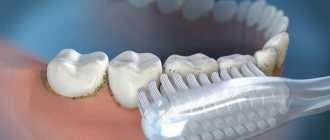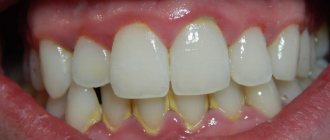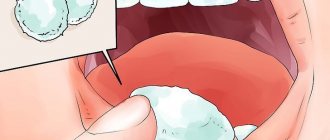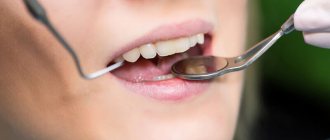Why do deposits appear on teeth?
The appearance of stone on initially light-colored teeth is due to various pathogenic and conditionally pathogenic microflora. The process is promoted by streptococci, lactobacilli, some types of Treponema and many other bacteria, the treatment of which is impossible due to their widespread distribution. Plaque is nothing more than the products of their active life in the oral cavity.
Daily brushing of teeth is not able to completely remove this deposit, even if done after every meal. After all, not all hard-to-reach places can be reached with a regular brush or thread. Interdental spaces, crevices and grooves in the back teeth, as well as the area of the neck of the tooth are difficult to clean on your own.
Why is it important to do professional hygiene?
It is impossible to thoroughly clean plaque from under the gums, between teeth, and in the area of 7-8 teeth with a regular brush.
Gradually, food debris, under the influence of acids contained in saliva, is mineralized and transformed into a solid formation, and this is fertile ground for carious bacteria. Their development in raid is fraught with two problems:
- Caries. Bacteria “eat” first the enamel, then the dentin, reach the inner part of the tooth - the pulp and penetrate the root. If you start caries, it can lead to complete destruction.
- Periodontitis. Accumulating under the gums, the stone moves them away from the dental tissues. This is how periodontal pockets are formed, where the infection actively develops and causes inflammation. Gum tissue atrophies, teeth become loose and fall out.
To avoid these problems, you need to visit the dentist every 6 months for ultrasonic cleaning.
Types of Tartar
Before you treat dental deposits, you need to understand what they are. The deposit can be soft or hard, with the former transitioning into the latter. Naturally, it is easier to treat the first option. Also, depending on the location, supragingival and subgingival deposits are distinguished. The first ones are easily identified, since they are not hidden by the gum. Identifying the latter is difficult, since they are covered by the gums.
When soft plaque accumulates and has not been removed for a long time, it hardens and thickens, resulting in the appearance of deposits on the teeth. These deposits can only be removed in a dental office using a special technique.
Cost of services
Laser cleaning requires high professionalism of doctors. For this reason, you need to approach the choice of dentistry with special attention.
Clinic A-Medic is a laser dentistry center that provides laser teeth cleaning services at the best prices in Moscow. We are confident in the quality of the work of our specialists, so we provide a guarantee of results. On the clinic’s website you can always read reviews from our patients, as well as see “before and after” photos of cleaning.
The cost of services is indicated in the fixed price list. All information about prices, specialists and the procedure itself can be found on the dentist’s website or from the center’s consultants by phone. Pre-registration is available on the clinic website. Leave a request and our specialists will contact you to schedule a consultation with a doctor at a time convenient for you.
Existing contraindications
Contraindications to the treatment of deposits are not as extensive as one might think. Treatment is not carried out only in cases where the patient is in an exacerbation of any chronic disease or advanced oncology has been identified. Also, treatment is not carried out in the acute phase of the inflammatory process, during the period of active colds.
Consultation and diagnostics
Making a treatment plan
Treatment procedure
Preventive examination
Indications
- Tartar deposits.
- Treatment of caries.
- Gingivitis and periodontitis.
- Mobility of teeth.
- Wearing braces.
- Preparation for prosthetics, implantation, orthodontic treatment.
Our doctors
Aftaeva Svetlana Viktorovna Sign up
Kuzovleva Natalya Vladimirovna more than 15 years of experience Sign up
Choosing a method
Deposits on teeth can only be removed in a dental clinic using modern techniques, such as ultrasound, powder jet, instrumental, etc.
Ultrasound method
Ultrasonic cleaning uses a so-called scaler, the tip of which creates oscillatory movements with a frequency of 25-30 thousand Hz. Thanks to this, all deposits, both hard and soft, are removed.
Air-Flow method
With the Airflow powder blasting technique, soft deposits disappear instantly. The essence of this technique is to supply a strong aerosol jet through a special thin tube. It consists of air, water and a cleaning powder that knocks down all deposits from the most remote corners and gum pockets, up to 10mm deep.
Dry cleaning
Chemical treatment of deposits is based on the use of a special composition that easily softens deposits and allows them to be removed from teeth without difficulty. The procedure has many disadvantages (for example, the likelihood of damaging enamel or soft tissue, an unpleasant taste in the mouth, the inability to cope with hard deposits), which is why it is used less and less in practice.
Mechanical cleaning
The instrumental method - curettage, is used in cases of stone deposits in the gum pockets and under the gums, when other methods are ineffective. In this case, not only deposits are removed, but also pathologically altered gum tissue.
Laser Application
Laser technology in the treatment of dental plaque has proven itself to be effective and safe. In this case, the deposit is removed layer by layer, a painless method. The disadvantage is the high price, but the treatment is suitable even if children need help.
Ultrasonic exposure
Ultrasound removal of tartar is a currently popular technique. A special ultrasonic scaler transmits high-frequency vibrations, which, when touching the surface of the tooth, destroy unnecessary formations. The final stage of the procedure is the removal of plaque microparticles using a stream of air and water.
Prices for ultrasonic tartar removal are also variable and high; many clinics offer clients discounts on subsequent cleanings, since the procedure must be carried out repeatedly.
Dangers of tartar on teeth
If the layers are not treated in a timely manner, you may encounter a whole range of complications. Some of them can even lead to the loss of your own teeth if the symptoms are not dealt with in time.
The deposit on the teeth can be colored in different shades by natural dyes such as coffee, wine, tea, cigarette smoke, etc. But discoloration is not the whole problem; the appearance of bad breath also creates many problems due to the development of microflora.
It doesn’t matter how dense the deposit on the teeth is, but microorganisms and bacteria develop in it, which cause the development of inflammation, and as a result, damage to the gums. The sharp edges of the stone injure the gums and cause bleeding of the gums, loosening of teeth and their loss. Today it has been proven that plaque is a very strong factor contributing to the appearance of gingivitis and various other inflammatory diseases. Therefore, removing tartar from teeth can become one of the main preventive measures against various types of gum pathologies.
Caries
In the absence of treatment of the deposits, a person often faces caries. Its cause is streptococci, which soften tooth enamel. Caries is a constant source of infection in the body. It also destroys teeth.
Periodontal disease
With periodontal disease, the necks of the teeth are gradually exposed due to the influence of pathogenic microflora. This disease is fraught with early tooth loss.
Gingivitis
Gingivitis is a disease accompanied by inflammatory processes in the gum tissue. Pathology quickly leads to loosening and loss of teeth.
Periodontitis
A disease accompanied by inflammation of the tissue surrounding the tooth is called periodontitis. If treatment is not carried out on time, there will be complaints of bleeding gums and bad breath. In especially advanced cases, teeth will fall out completely.
Cost of dental plaque removal
We have already written above that this procedure has a cost that is quite affordable for a wide range of patients. But in different clinics the price may be different: this is explained by the fact that different dentists include a different set of procedures in the dental plaque removal service. Most often, a complex is offered that includes ultrasonic teeth cleaning, Air Flow polishing and fluoridation. The cost of such a comprehensive service in Moscow will start at 4,500 rubles.
You can undergo the procedure for removing dental plaque in comfortable conditions and using ultra-modern technologies and equipment in our dental clinic in Moscow - VENSTOM. You can find out all the details about the service and about making an appointment with our specialists by writing to the chat on our website or calling us!
Preventive measures
Prevention of deposits involves good, regular oral hygiene. To do this, you need to brush your teeth daily, several times a day, using not only a brush, but also a special floss. It is also recommended to use pastes with high abrasive properties, consume birch and lemon sap, and raw fruits and vegetables in large quantities. gels that strengthen tooth enamel.
Following these simple recommendations will allow you to remove deposits with the help of professional intervention less often, about 2-3 times a year. gels that strengthen tooth enamel.
It is recommended to carry out the procedure for removing deposits on teeth twice a year; in this case, not only the aesthetic appeal of your smile will be achieved, but also the prevention of various inflammatory processes in the gums. Also, after the teeth cleaning procedure, they are polished with special fluoride-containing gels that strengthen tooth enamel.
Which plaque and stone removal method should I choose?
The procedure should be chosen by a dentist who takes into account the following factors:
- volume of tartar and plaque;
- quality of teeth;
- the presence of orthopedic structures, crowns, fillings, veneers, lumineers;
- individual wishes of the patient.
Dentistry "Zuub.rf" offers a full range of professional teeth cleaning from tartar and plaque. Effect the first time, without pain or discomfort, at an affordable price. Sign up for an initial consultation with a specialist to decide on the type of service and other important nuances of professional hygiene.
What types of formations are there?
From a practical point of view, specialists separate hard plaque depending on its location. It can be supragingival and subgingival.
- Supragingival tartar is clearly visible even during visual inspection. To a greater extent, its accumulations are found on the most distant teeth and on the inside of the front teeth of the lower jaw.
- Subgingival tartar is invisible during a routine examination of the oral cavity at a mirror, since it is concentrated under the gum, in periodontal pockets. Only a doctor can detect such deposits using dental instruments. The reason for contacting professionals to clarify the situation and carry out a hygienic procedure should be such signs as red or bleeding gums, bad breath.
Depending on the location of the tartar, the doctor chooses the most optimal way to remove it.
Reasons for appearance
The appearance of tartar is associated with the following prerequisites:
- Failure to comply with hygiene rules, when cleaning teeth with a toothbrush and toothpaste is carried out irregularly or is of insufficient quality. At the same time, there are always places in the oral cavity of any person where it is not easy to remove plaque on your own: the interdental spaces, the area of the neck of the teeth.
- Lack of dense foods in the diet that promote self-cleaning of teeth.
- Chewing on one side only, which occurs when teeth are lost or pain on the other.
- The presence of pathological processes in the body, characterized by impaired mineralization of saliva and an increase in its viscosity.
The formation of tartar is also promoted by a developmental anomaly such as crowded teeth.
Methods for removing tartar
Soft plaque can be removed using simple methods such as a toothbrush and toothpaste, as well as using the Air Flow device. However, in the case of hard tartar, these methods will not be effective due to its stony nature. The desired effect can be achieved with ultrasound . This procedure guarantees results in all hard-to-reach places, including subgingival pockets. During this process, it will be possible to get rid of pathogenic bacteria.
Operating principle of ultrasonic cleaning
method of removing tartar is based on the use of a special apparatus equipped with a tip with a special attachment. In it, electrical energy is converted into ultrasonic energy and directed to areas that need treatment. Under the influence of ultrasound, a dense stone is separated from the tooth surface and crushed into separate, smaller parts, which are then easily removed from the oral cavity with a stream of water or suction. In this case, the dentist can change the operating mode of the scaler, selecting the most suitable oscillation frequency.
Pros and cons of ultrasonic tartar removal
Advantages of ultrasonic cleaning:
- Highly effective for a variety of localizations of tartar, its occurrence between teeth, under the gums, and in the area of periodontal pockets.
- Safety, since damage to the structure of tooth enamel is excluded, as can happen during mechanical cleaning with instruments, hooks and brushes. Thanks to modern equipment, ultrasound does not have a negative effect on existing restorations in the oral cavity or installed veneers.
- Quite comfortable feeling. Possibility of using local anesthesia with a low pain threshold.
- Short session duration, no more than one hour.
- Availability.
Disadvantages of ultrasonic cleaning:
- Some restrictions on the use of the technique . Contraindications to ultrasonic dental tartar removal the patient has a pacemaker, increased tooth sensitivity, severe heart pathology with arrhythmia, or bronchial asthma. You will also have to use alternative methods in case of pregnancy or respiratory tract infection.
- Age restrictions, when due to the too thin layer of enamel of baby teeth, the use of this method of exposure is contraindicated in children.
How to clean teeth with ultrasound: stages
Ultrasound removal of tartar at clinic begins with an examination of the oral cavity, identification of all areas of accumulation of dental plaque, and identification of associated factors that may influence the choice of method .
If the decision is made in favor of ultrasound, then the doctor prepares the scaler, connects it to a source that generates an ultrasonic wave, and directs the nozzle to the areas of greatest accumulation of mineral deposits. As small particles form, they are removed from the mouth.
According to patient reviews , tartar removal takes place in comfortable conditions. Generally, people rate the sensations during the procedure as painless. They can be unpleasant when a large amount of tartar accumulates or when periodontal pockets are treated. In these cases, pain can be avoided by using local anesthesia.
The procedure does not end there. The next stage is teeth polishing, aimed at eliminating all irregularities and microcracks that form on the enamel after cleaning the teeth. The remaining roughness will become a prerequisite for the subsequent adhesion of microparticles of food, cariogenic bacteria and the formation of plaque. At the same time, a high-quality procedure will slow down the process of plaque re-formation and will keep your teeth smooth and shiny. Teeth are polished using special polishing attachments, as well as pastes of varying degrees of abrasiveness. Since they are supplemented with useful substances that help strengthen teeth, the preventive effect is only enhanced.
Fluoridation of teeth can be an independent method of prevention. However, in an effort to obtain the most significant result of ultrasonic cleaning, specialists often include it as part of a comprehensive procedure. It is aimed at improving the mineral composition of the enamel, thereby eliminating increased tooth sensitivity, strengthening the enamel, and preventing caries. The essence of fluoridation is the treatment of teeth with preparations containing fluoride ions. After removing tartar with ultrasound, the enamel perfectly absorbs beneficial substances. The procedure involves applying a solution rich in beneficial minerals tooth Instead of a brush, the doctor can also use mouth guards.
When contacting the Evita clinic for professional teeth cleaning, you can count on the hygienist to give advice on maintaining oral hygiene at home, as well as recommendations on what measures should be taken to avoid increased tooth sensitivity after the procedure and prolong the achieved effect . The advice concerns the following conditions:
- Follow a moderate temperature regime for the food you eat, and also temporarily exclude overly sweet or sour foods;
- During the first days, brushing your teeth is necessary after every meal. In this case, a soft toothbrush should be used as a basis, and among toothpastes, preference should be given to a product containing fluoride. You should stop using dental floss for 1-2 days.
A few days after the procedure, hygiene procedures can already be carried out as usual. At the same time, dental will definitely focus on the fact that if you adhere to a white diet and stop smoking for several days after ultrasonic cleaning, then the achieved improvement in the appearance of your teeth can be prolonged.
Most adult patients require ultrasonic cleaning on average twice a year. However, since its frequency is largely influenced by individual prerequisites, the doctor will also indicate the time of the subsequent visit.
How much does it cost to remove tartar using ultrasound?
The price of tartar removal depends on a number of factors:
- Equipment used. Despite the use of modern equipment, the cost of services at the Evita clinic is as competitive as possible.
- The size of the processing area. The noticeable difference in price will depend on whether one tooth or whether ultrasonic cleaning is necessary for the entire dentition.
- Doctor's qualifications. By contacting the Evita center, you will feel from your own experience that the specialists have sufficient practical experience in this field of activity and have the necessary knowledge and skills. According to reviews, ultrasonic tartar removal in our clinic is indeed performed at the proper level.
Taking into account all these factors, as well as the fact that the specialists of the Evita clinic guarantee a high level of procedure, our center is preferred for ultrasonic teeth cleaning. Any person who cares about the condition of their teeth and wants to avoid the need for treatment of caries or periodontitis has every chance to use this service. It is also necessary to consider the possibility of carrying out the procedure in our center due to the fact that the removal of tartar is usually not covered by the compulsory medical insurance policy, and this procedure in other clinics is also carried out only on a paid basis.
Removing tartar at home
Experts' recommendations regarding the removal of soft plaque regarding the use of hygiene accessories such as a toothbrush, toothpaste and floss are clearly developed, and their effectiveness is beyond doubt. As for the elimination of hard dental plaque, the situation here is more complicated, and it is not possible to ensure the required level of hygiene with these means. The result will not be what the patient expected, even if we focus on a toothbrush that uses electrical energy or ultrasound.
Professional teeth cleaning is possible only in a dental center, where it will be carried out by a qualified specialist who has the necessary skills and uses the appropriate equipment.
Prevention of dental plaque
Despite the fact that it is not possible to safely remove tartar at home, every person has the power to prevent its occurrence. With regular and proper oral care, dental plaque can be avoided or its appearance can be delayed. Good oral hygiene ensures that plaque is removed before it hardens. According to the recommendations of experts, you need to brush your teeth twice a day, choosing a toothbrush with soft or medium-hard bristles. Since a regular toothbrush will not give results in the interdental area, special dental floss should not be ignored.











